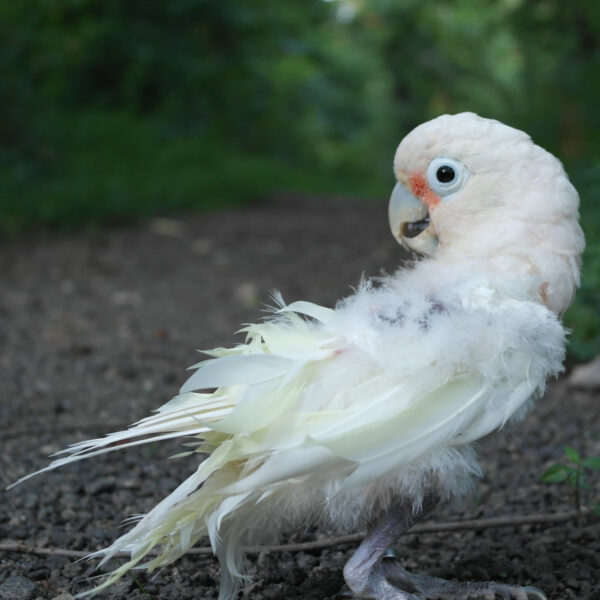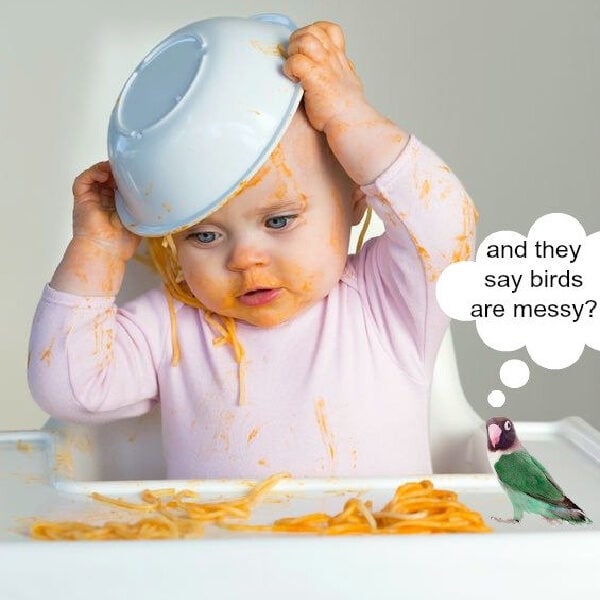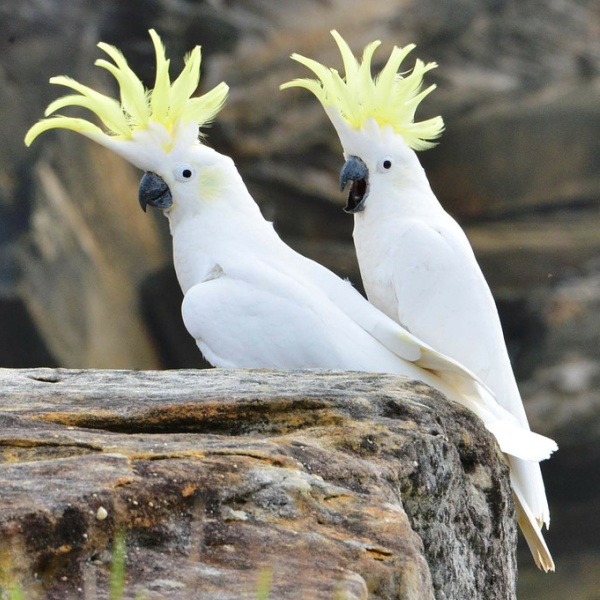Last Updated on by Catherine Tobsing
Hello, knowing of your holistic approach to things here is a synopsis of our bird and situation. We have an 11 1/2 yr old Goffins Cockatoo, Taedo ( we have had him since 2008 when he was 3 mths). We did have him sexed and know he is a male.
We have 2 Avian vets, know bird breeders, have a few local (Indianapolis, IN) bird stores with knowledgeable people as resources available, research books and other info, and receive your newsletters.
We consider information and its sources carefully and have learned and implemented a lot from the advice and info given, in caring for our bird.
He has been on a Zupreem Pellet diet (since he was weaned), within the last 2 years we added/mixed it with Tropican Lifetime Formula, he gets human food regularly, (but not as many fruits and veg as he should) and we give him additional treats of nuts, Nutri-berries, millet/seeds, tea and biscuits, and occasional whipped cream or ice cream.
Editors note: To own or keep some species of animals you need a permit or CITES papers. Goffins are one of those species.
He has an upstairs large sleeping cage, a downstairs daytime corner cage, and a mobile tree that we have on an outdoor screened sun porch.
We do the cage setups with lots of hanging toys that we buy and make (from repurposed plastic lids, straws, beads, and other toys), we place forage bins on the bottoms and he has different perch and rope options in each cage.
We line the cages using puppy pads.
He gets baths occasionally, (maybe 1 a week-ish and squirt with water mist occasionally as well)- probably not as much as required.
We have 2 cats and a dog and work from home, so he gets ample attention and some out-of-cage time.
He does like to have a heater (a couple of feet away) on for periods of time through the day for a few hours.
For years we used to clip his wings way back, then within the last year and a half had allowed his wings to come back to fully flighted until last week.
We just had a few wings clipped again for safety reasons, but he does still have some lift and flight available.
In 2010 when he was 2 yrs old we took him to an Avian Vet for a full and complete exam, he was healthy and normal in all ways but was plucking a few of his facial and chest downy feathers.
We received info and care instructions and had no other problems or issues with him for about 6 1/2 years.
In 2016 around the spring, he started some on/off plucking a few of his chest feathers again and then some of his leg feathers.
We consulted some local advice and watched and waited, it was intermittent and he’d seem okay for a while and then would go at it again, there was some assumption that it may be hormonal, but it progressed until he didn’t have any chest or legs feathers.
Late summer of 2017 he started plucking more when new feathers would come in he would be more agitated and aggressive and get to the point of plucking his skin.
Note here:* We have always covered his cage at night and he would go right to sleep once covered.
In the middle of one particular night, he just started screaming loudly and wouldn’t stop.
He started moving his head in a rhythmic C way back and forth, and up and down, in a weird way that we’d never seen.
He did this for a few days and then stopped, he seemed okay and back to “normal” behavior and fine overall in his demeanor and sleep, etc…but it is when we noticed the increased feather plucking.
We took him to a reputable and well-known Avian Vet in Cincinnati.
Weight normal, Mouth swab showed some bacteria, fecal test, and blood work were all normal.
The Dr. said there could have been some allergy-related itching or something that caused him to first start to pluck, then it became habitual to release endorphins.
He was given an antibiotic, anti-inflammatory meds, and haloperidol/antihistamine injection.
Those helped a bit at first, some feathers started to come back but then the shafts were being plucked again.
We took him to our regular local Pet Vet who also specializes in exotics – he gave Oral Hadol which only made our bird loopy and still didn’t help much.
Back to Avian vet in Cinnci for more rounds of haloperidol, after another 4 months and still no real evident effect.
We stopped the medicine in mid-March.
Taedo continued to pluck and would get little open wounds from taking out the feather shafts, even to the point of bleeding.
On May 25th we took him to our local Avian vet whom he had seen back in 2010. She has a different approach- stating that there has to be some underlying medical condition.
So far, Wt. and Blood-work again normal, Barium for the digestive track- all normal. Radiographs for reproductive- showed slightly swollen gonad which the vet was not too concerned about.
X-rays also showed “a single semi-bright rounded foreign object in the ventriculus (gizzard) -at the first view- 2mm x 1mm then said different view- 25mm x 25mm” After spending $1300 on these vets and tests, there is a further “Treatment Plan” for another $1300 which includes, Diagnostic endoscopy, skin biopsy, skin biopsy surgery, Lead and zinc testing and possible surgery for foreign object removal.
However, they don’t want to do any surgery unless all other testing is done first.
Aside from the plucking issue, our bird seems pretty “normal”, alert in behavior and attitude, and is pretty good and content overall.
He is self-contained and plays well with his toys and moves around in his cage. He eats well, has normal droppings, he has some squawk time, but is relatively quiet most of the time compared to other birds and cockatoos that we’ve known.
So, we’d like to be a bit more conservative in this and try a few things that we should have tried before and didn’t.
One main thing we did not do was the full spectrum lighting, our reasoning at the time was:
1) Because we had heard some conflicting information about it.
2) It wasn’t readily recommended from some of the resourceful people that we know, nor the Avian vets we’ve seen.
3) We assumed that since our bird was pretty good about knowing his Circadian clock rhythms of when to wake and bed, he was doing okay.
4) He would have outside time in the sunlight on a screened porch and was positioned by windows bringing in light, that it may have been adequate.
In retrospect that was probably wrong thinking, and we just ordered the lighting.
We also moved his cage away from corner windows, we had placed “sight barriers” over the cage so that it filtered in light but that the bird couldn’t see out of.
But now placed him back within two full walls.
Given the above info- is there anything that you would suggest or that we should consider doing differently or further? (i.e. lead/zinc testing, or skin biopsy, food, etc.?
Thank you in advance, Alex Akers
WOW!
Your efforts are nothing short of monumental Alex.
We know what it’s like to spend thousands of dollars on chasing a diagnosis in a bird.
First of all, I’d like to share with you my thoughts on Haldol
In this post, I annotate an hour-long interview with a well-known vet who was an early adopter of Haldol.
I think it’s creating an opiate epidemic for birds, you can reach your own conclusion.
Now that you have the appropriate lighting I would suggest 72 – 168 hours of constant light keeping your Too, locked in the cage for the entire time resetting Taedo’s circadian rhythms.
This can only be done with light therapy.
In general, veterinarians tend to belittle the enormous benefits of light because they can’t profit from it in spite of its proven efficacy.
I don’t know what you paid for those Haldol injections but my assumption is they were not cheap.
Understand I am not a degreed caregiver but I have friends in high places.
Your veterinarians can check with Dr. Gregory Harrison the founder of Harrison’s bird food who I got the initial idea of light therapy from.
It is also being studied/used at the Hagen Avicultural Research Institute in conjunction with the Guelph school of veterinary medicine a beneficiary of Mark Hagen’s (Hagen Bird Food) philanthropy.
I’m going to intentionally oversimplify your bird’s plucking problem.
In that you have come this far, I’m going to ask that you try something very simple nutritionally.
Halt the Zupreem and the Tropimix.
Zupreem has added sugar for “palatability”
Sugar lowers your birds (and your) intestinal pH making things more acidic.
So I want to rule out birdie heartburn, which would occur in the chest area.
I would swap the Hagen Tropimix (which contains Tropican pellets) with HARI Tropican Alternative Formula which has no soy or corn.
We know soy can be a plucking trigger.
We also know Mark Hagen, the developer of HARI bird foods.
Mark has a master’s degree in Agriculture.
At HARI, which he founded, they keep about 250 pairs of domestic and wild-caught parrots who are tested daily by 3 staff veterinarians and a host of vet techs.
Their avian knowledge base is second to none.
Why don’t you hear about their research, he asks rhetorically.
They are commercial bird food manufacturers who are quite stingy with their information in order to keep it out of competitors hands.
Moving along.
I would also advocate letting your bird be fully flighted.
Especially with other animals in the house, for his safety.
A flighted bird is healthier more confident and much less skittish knowing that it can fly away sensing a hint of danger.
I noticed the sleeping cage picture of the cage is appointed quite nicely but the bird is sleeping on a swing with a grooming perch that he is on all night.
Learn why that’s an issue here.
His feet may be compromised and at the next opportunity, I would take a very close look at the bottom of his feet to make sure he’s not in pain from gripping the abrasive surface 10 to 12 hours a day seven days a week.
This too can be another plucking trigger and I would eliminate that ASAP than moving the existing soft computer oh perch a little higher in the cage or adding an additional one in the large size.
Booda rope comfy perches not only help reduce foot abrasion while sleeping, but they also offer fabric that can be chewed on which is an alternative to feathers.
Re: “He started moving his head in a rhythmic C way back and forth, and up and down, in a weird way that we’d never seen”.
That may have been something as simple as “night frights” or as complicated as a seizure, but it’s likely we’ll never know for sure.
Lastly, I would advocate losing the puppy pads.
They are absorbent harboring harmful bacteria.
Fecal particulate ends up in the air and the air passageways of every species in your household.
Newspaper is fine and can be changed daily.
It’s not harmful to your birds whatsoever.
It’s cheap and plentiful – for now.
Let’s start with this short to-do list then let us know how it goes with Taedo.
Best of luck
MitchR
Author Profile
Latest entries
 The Traveling BirdJune 26, 2025Can You Name 5 Parrot Species That Are Living Wild in the USA?
The Traveling BirdJune 26, 2025Can You Name 5 Parrot Species That Are Living Wild in the USA? Bird BehaviorJune 26, 2025How is it Parrots Are Problem Solvers Social Animals and Even Use Tools?
Bird BehaviorJune 26, 2025How is it Parrots Are Problem Solvers Social Animals and Even Use Tools? Bird & Parrot AnatomyJune 25, 2025How a Tiny Chemical Modification Makes Parrots Nature’s Living Paintings
Bird & Parrot AnatomyJune 25, 2025How a Tiny Chemical Modification Makes Parrots Nature’s Living Paintings PigeonsJune 20, 2025How Do Parrots Thrive in Cities Outside Their Native Habitats?
PigeonsJune 20, 2025How Do Parrots Thrive in Cities Outside Their Native Habitats?




